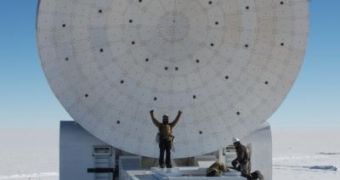A team of experts from nine research institutes are going to try to find the “first light” of the Universe over the next 10 years, its starting point, or at least the closest one they can link to it. In truth, they will be looking for very, very faint traces of gravitational waves, which Einstein's theory of relativity says should be there, if the Universe was indeed formed 13.7 billion years ago. According to the most popular hypothesis, everything around us was created by a microscopic density fluctuation in the fabric of space and time. From it, all of the galaxies, clusters and black holes appeared.
“If you detect gravity waves, it tells you a whole lot about inflation for our universe,” and prove other theories wrong. “There are fewer than there used to be, but they don't predict that you have such an extreme, hot big bang, this quantum fluctuation, to start with,” the University of Chicago S. Chandrasekhar Distinguished Service Professor in Astronomy & Astrophysics, John Carlstrom, says.
“We have these key components to our picture of the universe, but we really don't know what physics produces any of them. The goal of the next decade is to identify the physics,” Fermi National Accelerator Laboratory scientist Scott Dodelson, also a Professor in Astronomy & Astrophysics at the University of Chicago, adds when talking about the complex interactions that exist between the inflation rate of the Universe, dark matter, and dark energy.
The researchers have presented their work, “Origins and Endings: From the Beginning to the End of the Universe,” at the annual meeting of the American Association for the Advancement of Science (AAAS) in Chicago. They have also worked with Alan Guth, the MIT scientist that in 1979 proposed a theory stating that there was in reality an infinite number of Universes in existence. The team is very frustrated by the fact that, no matter how hard they would try to prove their claims, there is no possible way to verify their hypotheses.
“Since these are separate universes, by definition that means we can never have any contact with them. Nothing that happens there has any impact on us,” Dodelson maintains. Now, the researchers are building a special instrument named polarimeter, which they will attach to the South Pole Telescope in order to get a better “resolution” for the gravity waves they are trying to identify.

 14 DAY TRIAL //
14 DAY TRIAL //